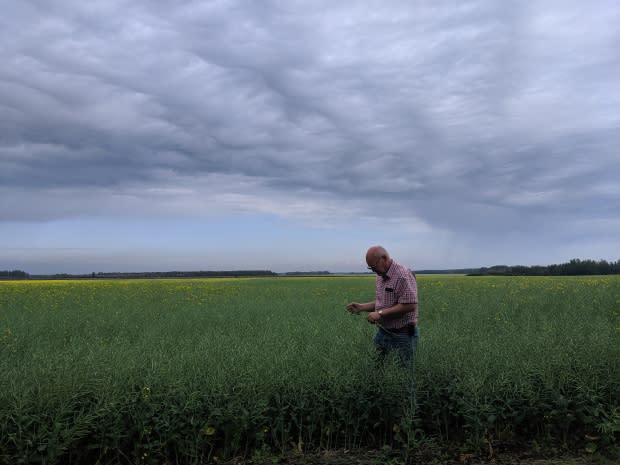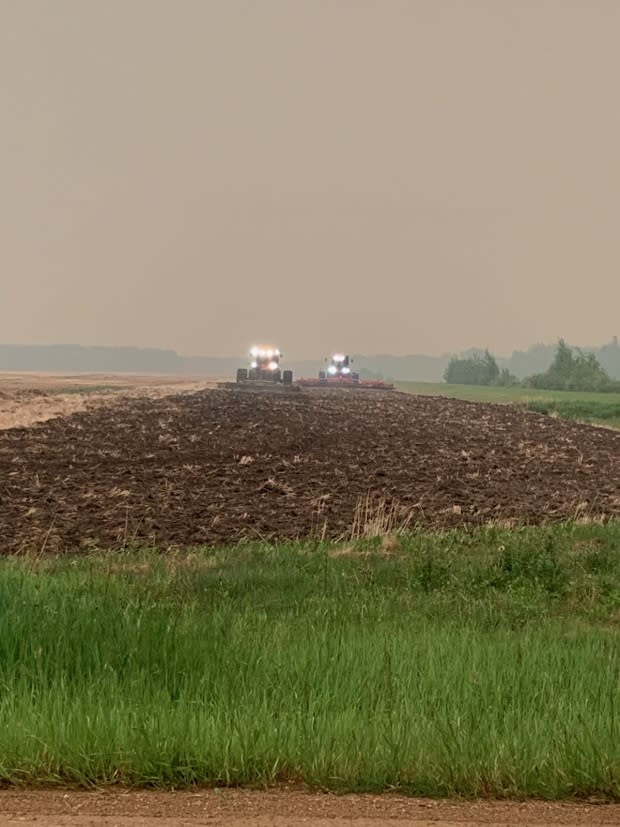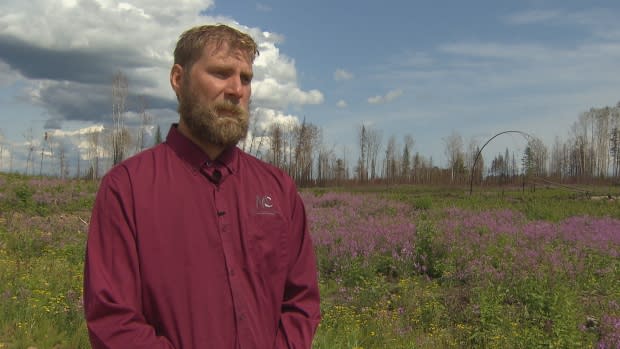'Ripe to burn': Northern Alberta farmers face down wildfire threat
The sky was black with smoke as Joe Peters watched his neighbours turn his planted canola field back to dirt.
It was around 3 p.m. on June 17, at what should have been the height of Mackenzie County's growing season.
Instead, a group of farmers worked hastily in the dark, trying to improvise fire breaks.
Tractors pulling disc harrows plowed strips of planted fields and last year's stubble, turning the soil so there was nothing left to burn.
"We knew where we were, but even while we were doing it, we had no idea, would the fire consume us in five minutes or not? But we felt if we didn't do this, and the fire came, we had just way too much to lose," Peters said.

The tractors were trying to outrun the approach of the Chuckegg Creek wildfire as it raged in the boreal forest surrounding about 263,000 hectares of farmland tucked into Alberta's northwest corner.
Standing in his farmyard over a month later, Peters recalled the stress he and his neighbours were under when they realized the fire was headed their way.
"Having had droughts for so many years, and a forest that hasn't had a fire for over 100 years, it was just ripe to burn. And the ducks lined up this year and it exploded."

Peters and other farmers are still hoping to salvage this year's harvest, but delays in field work and the possibility of an early frost have piqued worries about crop loss. Alberta Wildfire declared the Chuckegg Creek fire held in late July. By then it had burned an area about the size of Banff National Park, forcing the evacuation of 15,000 people from more than 20 communities.
Sixteen homes on the Paddle Prairie Métis Settlement were destroyed. A farmhouse in Mackenzie County burned, but the fields were largely spared. Peters said the fire advanced to within five kilometres of his land near High Level.

From above, the farm fields look like they fared well compared to the burned trees at their borders, as though a quilt of bright yellow canola and green cereals was laid over top of the hills and forests that surround the Peace River.
But on the ground, farmers and county officials are reckoning with their close call.
"A wildfire in farmland is very different than it is in an urban centre," said Mackenzie County Reeve Josh Knelsen, citing the fires that ravaged Slave Lake in 2011 and Fort McMurray in 2016.
Walking away from a farm is different from walking away from a house, Knelsen said. If a farmer is forced to evacuate and can't keep a close eye on crops, cutworms could move in and decimate a field in two days.

"There is continual work, there is continual monitoring that needs to happen," Knelsen said. "They have to be very vigilant if they want to make a living."
Telling farmers they have to leave and risk losing their crops isn't an easy sell. Even harder? Forcing them to leave their animals behind.
Grant Smith, the agriculture fieldman for Mackenzie County, said his most pressing concern in the wake of the fire is a consultation with emergency management specialists about identifying a trigger time for evacuating livestock.

Smith said by the time the county realized an evacuation was needed, Alberta Wildfire told them it was too late to move everyone's cows, horses and chickens. Though a few animals were moved out, many farmers were faced with the choice of whether or not to open gates, setting livestock free to roam for food or to flee the fire.
"We didn't think it would come to this, didn't think it could happen to us," Smith said. "That's the message I want to put out there: you are a sitting duck. I don't care where you're at. Don't get caught with your pants down like we did."
'The ecosystem is changing'
Smith and Knelson said the county wants to use this year's experience to work with the province on a better plan for area farmers and those in other Alberta agriculture regions that border forests.
Peace River MLA Dan Williams, who represents the county, said the province will take what farmers have to say into account as they plan for future wildfire strategies. He said farmers often have a better understanding of their terrain than people coming in with experience fighting forest fires.

Farmers weren't the only ones whose work was disrupted by the wildfire: the smoky conditions thwarted local bees, said local researcher Samuel Peprah, who manages the Mackenzie Applied Research Association.
"We humans, we need clear visibility for driving. So do the bees," Peprah said. "They need clear visibility to do the foraging."
The smoke also seems to have stressed out some plants, he said.
Peprah said the smoke causes plants' pores to close, delaying flowering and reproduction and preventing the absorption of herbicide. That means farmers who sprayed in hopes of killing off pests during smoky periods wouldn't have got results, he said.
Mackenzie County farmers now have to reckon with the delays combined with the risk of an early frost — a factor Smith said makes the county's crop insurance premiums the highest in the province. The northern location and short growing season mean farmers count on long daylight hours that come with the latitude. If farmers can't harvest early enough, they risk losing their yields.

Lessons gleaned from this year's experience are expected to be useful in years to come: according to a recent federal report, Canada has warmed much faster than the rest of the world in recent decades, and parts of northern Alberta even more so.
Smith said climate change is something farmers and the county are well aware of.
"You can call it climate change or global warming or whatever you want to call it. But the ecosystem is changing," he said.


